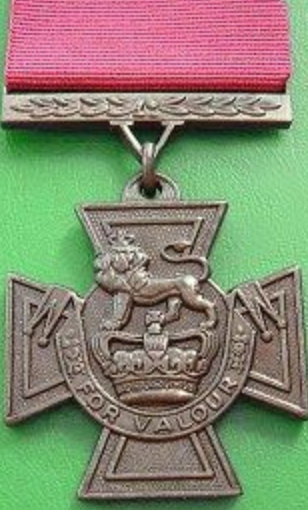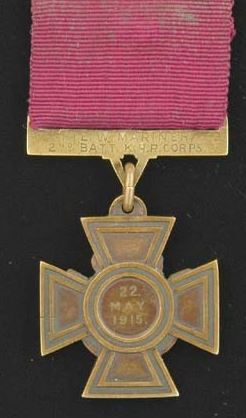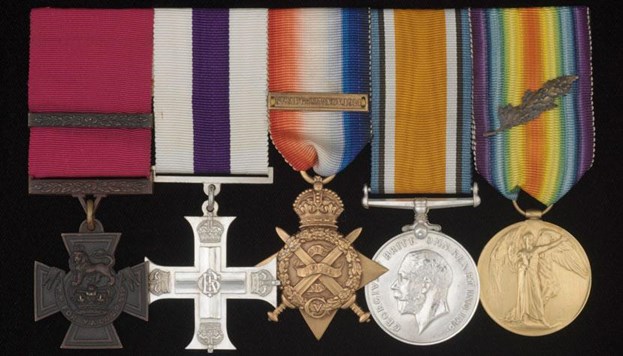Victoria Crosses Won on the Western Front 1914-1918
- Home
- World War I Articles
- Victoria Crosses Won on the Western Front 1914-1918

The Victoria Cross (VC) is awarded for 'conspicuous bravery in the presence of the enemy'.
For a medal that is awarded for supreme gallantry, it is a singularly plain, a variable dark brown in colour and relatively unadorned object. It is also quite small, only 1.4 inches by 1.4 inches, weighs less than an ounce overall (about 25 grammes). All this simplicity and gravitas only adds to its eye-catching appearance and mystique. Once one has seen it, or a coloured illustration of it, it is readily recognised even amongst a whole chest-full of military medals.
The VC is made from scrap metal cut from the terminal bosses (cascabels) of two Chinese-made brass cannons captured from the Russians at the Battle of Sevastopol in the Crimean War, 150 years ago. These boss-less cannon stand outside an Officers' Mess in Woolwich, on the River Thames, in London, England.
All the VC medals made to date, were cast and hand chased by the London Jeweller Messrs. Hancocks (now Hancocks and Company).
The designer of the VC is said to be Mr. A.H. Armstead, who was commissioned by Messrs. Hancocks. There is thought to be enough gunmetal remaining in safe storage to make another 85 VCs. Of course, there are still the two remaining barrels of the Russian guns as a further source of supply were it ever needed!
The form of the VC is roughly that of a Maltese cross, more properly described as a Cross Patté, i.e. with feet or paws: in actuality, the ends of the four ridged-edged arms of the cross just taper outwards. The suspender bar, which is adorned with a Roman-type laurel leaf cluster, is connected to the hole in the semi-circular lug at the top of the cross by a circular, or oval, link; all in the same gun-metal as the medal itself. In turn, attached to the suspender bar is a crimson red monochrome ribbon, from which the medal is suspended when worn above the pocket of the uniform on the left upper chest of the holder of the medal.
In the centre of the medal is depicted the regal lion astride the royal crown. Below this, on a swag, draped across the two horizontal arms of the cross, are written two words - For Valour.
Hidden on the reverse, are engraved, in capital letters, the recipient's regiment or unit, name and rank and the date of the deed that earned the award. These inscriptions are located in the circle at the centre of the crossed arms. If the inscription is long, abbreviations are used. No woman has yet received the medal.

Above: The reverse of the VC awarded to John William Mariner
When the VC ribbon is worn alone, a miniature VC is attached to centre of the ribbon.
In the rare event when the medal has been awarded more than once - only three times from June 1857 until June 2004 (the time of the writing of this article) - another simple bar is attached to the ribbon on the reverse of which are the details of the second award. In 1917, to accommodate the award of a bar, two miniature VCs, side by side, were authorised when the ribbon is worn alone.
Of the three bar awards, two were for British Medical Officers of the Royal Army Medical Corps, Surgeon Captain (later Lieutenant Colonel) Arthur Martin-Leake (1874-1953) and Captain Noel Godfrey Chavasse (1884-1917). The other bar was awarded (in the Second World War) to a New Zealander, Second Lieutenant Charles Hazlitt Upham (1908 -1994). Co-incidentally he was a distant relative of Captain Chavasse.
Captains Martin-Leake and Chavasse both earned their VC bars in the Great War. The former earned his first VC in the Boer War in 1902 and his bar on the Western Front in 1914 and the latter earned both his VC and bar on the Western Front in 1916 and 1917 respectively; Captain Chavasse's bar was awarded posthumously. He was also awarded the Military Cross (MC), in 1916.

Above: Noel Chavasse’s medals are part of the Lord Ashcroft Collection on display at IWM London.
The intrinsic value of the medal is a few tens of Pounds Sterling - not as frequently stated, a few pennies! Of course, it is priceless to the individual concerned, though many have been sold over the years by the recipients during their lives - often due to poverty or illness - and many more after their death. Today there is a very strong collector's market for any VC that is put up for sale; the current record being, in 2003, the sum of ?155,000 for the amazing array of a VC plus DSO and MC with bar, all awarded to the same person.
Many VC's are safely preserved in museums and collections - national, regimental and private - and, presumably, will not come on the market again except for very exceptional circumstances.
Such is the awe, respect and interest generated by this medal that few discussions by professional or amateur war historians about a particular Western Front battlefield, or action, take place without reference, at some point, to any VCs that were awarded, or recommended, in association with the location in question.
Conditions particularly relative to the award of the VC in the Great War.
- All ranks were eligible including women and boys.
- Although the necessary amending Warrant wasn't passed until 1920, the medal was awarded posthumously throughout the Great War.
- Details of the regimental, or unit, number were included in the inscription. The information given was often more detailed than was the case with earlier awards.
- The award could be forfeited for bad conduct. A rule that was not changed until 1920 by King George the V as a result of public demand. If the medal was forfeited so was the discretionary pension (in 1914-18 it was from ?50 to ?75).
As a result of the decision of King George V, the eight forfeited awards and the discretionary pensions were reinstated, including one from the Great War. - Under Rule 13 of the Royal Warrant that governs the award by the monarch of the VC, the medal could be bestowed, and has been 42 times over the years, as the result of a ballot of a group commended for their combined bravery. The group was asked to nominate one of their number whom they judged the most worthy. This, in principle, would seem to be an extremely fair and unbiased approach to a difficult decision.
- Recommendations for the Victoria Cross could only be accepted if properly sworn to and attested, in writing, by three persons who had actually seen the event. Accordingly, many extraordinary feats of bravery that were not so well witnessed, or where the witnesses were also killed, went unrecorded by default.
- By no means were all recommendations for the VC successful, although a lesser medal was often awarded in lieu. One senior officer of the Great War, General Sir Ian Standish Montieth Hamilton, commander of the Dardanelles Expedition, was unsuccessfully recommended three times during his earlier career.
- Some sources state that some of the VCs of the Great War were made from gunmetal other than that derived from the Chinese Sevastopol cannon. Exactly which medals are in question is not stipulated, except for the case of Lieutenant Robert Vaughan Gorle, of the Royal Artillery. His 1918 VC was tested by fluoroscopy by the authorities at the Tower of London, in 1997, and was declared to be not cast from the Sevastopol cannon metal.
- The only ungazetted award ever, was made in October 1921 by the British Cabinet to the 'American Unknown Warrior (Soldier)' of the Great War who is buried at the Arlington National Cemetery, Virginia, USA. The American Congress made an equivalent award (The Congressional Medal of Honor) to the British Unknown Warrior in May 1920.
- Throughout the war, the final decision as to whether the medal should be awarded to an individual, was made by the King, George V, who would, if at all possible, personally invest the award to the winner or, in the case of a posthumous award, to a close relative.
- The grave-stone of a holder of the VC who died in action, or from his wounds, also had a depiction of the VC engraved upon it as well as his regimental badge The grave-stone of Captain N.G.Chevasse VC and bar, MC, uniquely has two small VCs engraved side by side.
- In 1916 authorisation was given that a miniature version of the VC could be worn with Regimental Dress (Mess) uniform or formal evening clothes.
A total of 1354 Victoria Crosses have been awarded from its first investiture by Queen Victoria on 26th June 1857 (after the Crimea War, 1854-1856) to date (June 2004). It is rumoured that a recommendation arising from the Gulf War of 2003 was downgraded to a lesser medal.
Of that total, 628 were awarded during the Great War - 4th August 1914 to 11th November 1918 - which is (46%) of the total number of awards.
From the end of 1914, the Western Front was around 460 miles (760km) in length and up to 20 miles deep (32km). At certain points it was fairly static for most of the War (e.g. The Ypres and Verdun sectors) and at others it fluctuated considerably (e.g. The Somme sector).
If the Western Front is defined broadly as the area of warfare that took place in the front-line areas of countries of France and Belgium during those same four years, the total number of VCs awarded on the Western Front was 521 with 138 (26%) bestowed posthumously - roughly one in four.
It impossible to precisely assign all the VCs to a particular campaign, offensive or battle on the Western Front, but if this limitation is accepted the following rough designations can be made.
1914
- MONS, Belgium, August: = 5. [2 posthumously].
- THE AISNE, FIRST, France, August: = 3.
- LE CATEAU, FIRST, France, August: = 5. [1 posthumously].
- NERY, France, September: = 3. [1 posthumously].
- THE AISNE, SECOND, France, September: = 7. [1 posthumously].
- YPRES, FIRST, Belgium, October: = 8. [2 posthumously].
- OTHER FRONTLINE CITATIONS, October - December: = 12. (France = 11, Belgium = 1). [1 posthumously].
Total VCs on Western Front for 1914 = 43. (France = 29, Belgium = 14). [8 posthumously].
1915
- OTHER FRONTLINE CITATIONS, February - December: = 11. (France = 9, Belgium = 2). [3 posthumously].
- NEUVE CHAPEL, France, March: = 9. [3 posthumously].
- YPRES SALIENT, Belgium, March-April: = 6.
- YPRES, SECOND, Belgium, April-May: = 9. [4 posthumously].
- AUBERS RIDGE, France, May: = 4.
- FESTUBERT, France, May: = 3.
- ARTOIS, France, May-June: = 4.
- LOOS, France, September-October: = 21. [6 posthumously].
Total VCs on Western Front for 1915 = 67. (France = 50, Belgium = 17). [16 posthumously].
1916
- OTHER FRONT LINE CITATIONS, February-June: = 13. (France = 11, Belgium = 2). [4 posthumously].
- THE SOMME, FIRST, France, July -December: = 51. (1st July = 9) [14 posthumously].
Total VCs on Western Front for 1916 = 64: (France = 62, Belgium 2). [18 posthumously].
1917
- OTHER FRONTLINE CITATIONS, January-December: =30. (France = 27, Belgium = 3). [12 posthumously].
- ARRAS, FIRST, France, April-June: = 29. [11 posthumously].
- MESSINES, Belgium, June: = 4.
- YPRES, THIRD, (Including Passchendaele), Belgium, and July - November: = 60. [10 posthumously].
- CAMBRAI, France, November-December: = 18. [7 posthumously].
Total VCs on Western Front for 1917 = 141. (France = 74, Belgium = 67). [40 posthumously].
1918
- THE SOMME, SECOND, France, March-April: = 30. [13 posthumously].
- OTHER FRONT LINE CITATIONS, March-October: = 25. (France = 14, Belgium = 11). [4 posthumously].
- THE LYS, April: = 11. (France = 9, Belgium = 2). [3 posthumously].
- THE AISNE, THIRD, France, May: = 1.
- THE MARNE, SECOND, France, July: = 1. [Posthumously].
- AMIENS, France, August: = 14. [6 posthumously].
- ARRAS, SECOND, France, August-September: = 37. [8 posthumously].
- HAVRINCOURT, France, September: = 12. [3 posthumously].
- HINDENBURG LINE, France, September-October = 20. [3 posthumously].
- LE CATEAU, SECOND, France, October: = 8. [4 posthumously].
- THE SELLE, France, October: = 8.
- THE SAMBRE, France, November: =10. [3 posthumously].
Total VCs on Western Front for 1918 = 177. (France = 164, Belgium =13) [48 posthumously].
Overall total VCs on the Western Front 4th August 1914-1918 = 492 (France = 379, Belgium 113).[130 posthumously].
However, these figures are not yet complete, as two other categories need to be included. They are the 18 VCs of the air war (from1915-1918) - with six awarded posthumously - and the 11 VCs of the 1918 Zeebrugge and Ostend naval raids - with two posthumous awards. (Four of the 11 Zeebrugge and Ostend VCs were elected under the ballot system as detailed in Rule13 of the Royal Warrant).
This raises the Total for all the VCs on the Western Front to 521 with 138 posthumous awards, i.e. 27%.
Although the Zeebrugge and Ostend total could be included in the Belgian sector total, this does not seem quite appropriate as these ports were not really part of the Western Front in its truest sense.
As for the air war VCs - with six awards in 1915, one in 1916, five in 1917 and six in 1918 - it is impossible to allot some of them to either to the France or Belgium sectors: they were given for outstanding service over a period rather than a specific deed in a specific sector. A good example being the top British air fighter ace, Major Alfred 'Mick' Mannock, who had 72 victories that took place all over the Western Front. He was awarded his VC posthumously in 1918.
Distribution of the of the VC by rank.
Taken over the whole period of the war on the Western Front - 1914 to 1918 - commissioned officers were awarded 217 (42%) of the VCs and the other ranks 304 (58%).
Of the commissioned officer's VCs, significantly, 114 went to Lieutenants and 2nd Lieutenants, or their equivalents. This represents 22% of all the Western Front awards and 53% of the commissioned officer's awards. Since military rewards tend to reflect risk, it is obvious that the life of these generally young men doing their job on the Front-line of the Western Front, was indeed a potentially dangerous and challenging one.
Postscriptum.
Perhaps, the first impression that a researcher on any aspect of the Victoria Cross gets is how many (1,354) have been awarded over the past 147 years - an average of nearly 10 a year. Also remarkable, is what a relatively high percentage of them (38%) were bestowed on servicemen on the Western Front in the four years and three months that the Great War raged there.
If one is privileged to meet a VC holder - and it gets increasing unlikely, as there are only 12 still alive at the time of writing, a 106 year-old Australian holder from the Great War just died in June 2004 - it seems one is almost always impressed by their modesty and self-effacement. Reportedly, there have been exceptions to the rule.
Rightly, the VCs are mightily proud of their award. But from what one sees and hears, one gets the impression that whilst they truly appreciate it has been their great fortune to have their valorous deed recognised, they know full well that many other equally courageous deeds have not, by one kind of default or another, been so recognised and rewarded.
But, in the final analysis, allowing for an inherent and inevitable element of unfairness in the selection and decision process, it is probably good for a democratic society to recognise and celebrate that such valiant men are there among its people. And that this small select exemplar represents the many that have selflessly risked and sacrificed their lives, without such a high degree of recognition, to ensure we all live in freedom.
For readers who are interested in the biographical details of the individual holders of the VC, there are, of course, innumerable references and books on the subject. For an up-to-date reference that is likely to be currently available in the local Public Library, the author would recommend 'Symbols of Courage' by Max Arthur (2004) - ISBN 0 283 07351 9 - published by Sidgwick and Jackson/Pan MacMillan Ltd, London, England. The author would like to acknowledge that he has found this book most useful in verifying and cross-checking some of the data used in this article, whilst accepting that any errors and omissions are entirely his own.
(Details of the burial place of, and memorials to, Victoria Cross holders, can be found on this website in two articles, one covering the Western Front and another covering other fronts.)





